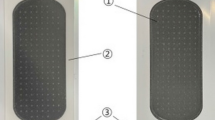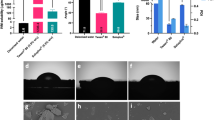Abstract
Background
The stratum corneum is an almost impermeable barrier. Recently, microneedles have been used to increase drug delivery passing the stratum corneum by incorporating the drug within the microneedle or by coating the surface of the microneedle with the drug.
Objective
This study was performed to investigate whether applying a biodegradable microneedle patch after topical steroid application increases penetration of the steroid in vitro, as well as treatment efficacy in patients with prurigo nodularis.
Materials & methods
In vitro penetration of topical steroids after biodegradable microneedle patch application was measured using a 3D skin model. To evaluate the treatment efficacy of the combination of biodegradable microneedle and topical steroids, a split-body clinical study was performed.
Results
Penetration of topical steroid in the in vitro skin model was significantly greater in the microneedle-applied skin. In a split-body clinical study with prurigo nodularis patients, the area and height of skin lesions decreased after four weeks of treatment on both sides, however, the microneedle patch side exhibited a significantly greater decrease in both area and height, compared to the control side. The pruritus visual analogue scale was also significantly lower on the microneedle side.
Conclusion
We suggest that simply applying a microneedle patch after topical steroid application could be a useful strategy for treating refractory skin diseases such as prurigo nodularis.
Similar content being viewed by others
References
Lee MR, Shumack S. Prurigo nodularis: a review. Aus J Dermatol 2005; 46: 211–8, quiz: 9-20.
Stander S, Luger T, Metze D. Treatment of prurigo nodularis with topical capsaicin. J Am Acad Dermatol 2001; 44: 471–8.
Wong SS, Goh CL. Double-blind, right/left comparison of calcipotriol ointment and betamethasone ointment in the treatment of Prurigo nodularis. Arch Dermatol 2000; 36: 807–8.
Stander S, Schurmeyer-Horst F, Luger TA, Weisshaar E. Treatment of pruritic diseases with topical calcineurin inhibitors. Ther Clin Risk Manag 2006; 2: 213–8.
Meyers LN. Use of occlusive membrane in the treatment of prurigo nodularis. Int J Dermatol 1989; 28: 275–6.
Saraceno R, Chiricozzi A, Nistico SP, Tiberti S, Chimenti S. An occlusive dressing containing betamethasone valerate 0.1% for the treatment of prurigo nodularis. J Dermatol Treat 2010; 21: 363–6.
Finnin BC, Morgan TM. Transdermal penetration enhancers: applications, limitations, and potential. J Pharm Sci 1999; 88: 955–8.
Guy RH. Current status and future prospects of transdermal drug delivery. Pharm Res 1996; 13: 1765–9.
Hadgraft J, Pugh WJ. The selection and design of topical and transdermal agents: a review. J Investig Dermatol Symp Proc 1998; 3: 131–5.
Kalluri H, Banga AK. Microneedles and transdermal drug delivery. J Drug Deliv Sci Tec 2009; 19: 303–10.
van der Maaden K, Jiskoot W, Bouwstra J. Microneedle technologies for (trans)dermal drug and vaccine delivery. J Control Release 2012; 161: 645–55.
Wang PM, Cornwell M, Hill J, Prausnitz MR. Precise microinjection into skin using hollow microneedles. J Invest Dermatol 2006; 126: 1080–7.
Brown MB, Jones SA. Hyaluronic acid: a unique topical vehicle for the localized delivery of drugs to the skin. J Eur Acad Dermatol Venereol 2005; 19: 308–18.
Kim JD, Kim M, Yang H, Lee K, Jung H. Droplet-born air blowing: novel dissolving microneedle fabrication. J Control Release 2013; 170: 430–6.
Yun S, Tearney G, de Boer J, Iftimia N, Bouma B. Highspeed optical frequency-domain imaging. Optics Express 2003; 11: 2953–63.
Sheikh S, Asghar S, Patni SA. A validated, specific stability indicating reverse phase liquid chromatographic method for the simultaneous estimation of phenylephrine HCL, betamethasone valerate & lignocaine HCL in pharmaceutical ointment. Int J Sci Res Pub 2012; 2: 1–8.
Shim J, Seok Kang H, Park WS, Han SH, Kim J, Chang IS. Transdermal delivery of mixnoxidil with block copolymer nanoparticles. J Controlled Release 2004; 97: 477–84.
Kumar R, Singh B, Bakshi G, Katare OP. Development of liposomal systems of finasteride for topical applications: design, characterization, and in vitro evaluation. Pharm Dev Technol 2007; 12: 591–601.
Munster U, Nakamura C, Haberland A, et al. RU 58841-myristateprodrug development for topical treatment of acne and androgenetic alopecia. Pharmazie 2005; 60: 8–12.
Vogt A, Combadiere B, Hadam S, et al. 40 nm, but not 750 or 1,500 nm, nanoparticles enter epidermal CD1a+ cells after transcutaneous application on human skin. J Invest Dermatol 2006; 126: 1316–22.
Nakamura M, Jo J, Tabata Y, Ishikawa O. Controlled delivery of T-box21 small interfering RNA ameliorates autoimmune alopecia (Alopecia Areata) in a C3H/HeJ mouse model. Am J Pathol 2008; 172: 650–8.
Anumolu SS, Menjoge AR, Deshmukh M, et al. Doxycycline hydrogels with reversible disulfide crosslinks for dermal wound healing of mustard injuries. Biomaterials 2011; 32: 1204–17.
Alemdaroglu C, Degim Z, Celebi N, Sengezer M, Alomeroglu M, Nacar A. Investigation of epidermal growth factor containing liposome formulation effects on burn wound healing. J Biomed Mater Res A 2008; 85: 271–83.
Gainza G, Aguirre JJ, Pedraz JL, Hernandez RM, Igartua M. rhEGF-loaded PLGA-Alginate microspheres enhance the healing of fullthickness excisional wounds in diabetised Wistar rats. Eur J Pharm Sci 2013; 50: 243–52.
Gainza G, Pastor M, Aguirre JJ, et al. A novel strategy for the treatment of chronic wounds based on the topical administration of rhEGF-loaded lipid nanoparticles: In vitro bioactivity and in vivo effectiveness in healing-impaired db/db mice. J Controlled Release 2014; 185: 51–61.
Backonja M, Wallace MS, Blonsky ER, et al. NGX-4010, a high-concentration capsaicin patch, for the treatment of postherpetic neuralgia: a randomised, double-blind study. Lancet Neurol 2008; 7: 1106–12.
Simpson DM, Estanislao L, Brown SJ, Sampson J. An open-label pilot study of high-concentration capsaicin patch in painful HIV neuropathy. J Pain Symptom Manage 2008; 35: 299–306.
Misery L, Erfan N, Castela E, et al. Successful treatment of refractory neuropathic pruritus with capsaicin 8% patch: a bicentric retrospective study with long-term follow-up. Acta Derm Venereol 2015; 95: 864–5.
Fernando GJ, Chen X, Prow TW, et al. Potent immunity to low doses of influenza vaccine by probabilistic guided micro-targeted skin delivery in a mouse model. PLoS One 2010; 5: e10266.
Wermeling DP, Banks SL, Hudson DA, et al. Microneedles permit transdermal delivery of a skin-impermeant medication to humans. Proc Nat Acad Sci USA 2008; 105: 2058–63.
Daddona PE, Matriano JA, Mandema J, Maa YF. Parathyroid hormone (1-34)-coated microneedle patch system: clinical pharmacokinetics and pharmacodynamics for treatment of osteoporosis. Pharm Res 2011; 28: 159–65.
Park J, Seo J, Shin JU, Jeong DH, Kim JD, Lee KH. Efficacy of biodegradable microneedle patches on periorbital wrinkles. Korean J Dermatol 2014; 52: 597–607.
Whitton JT, Everall JD. The thickness of the epidermis. Brit J Dermatol 1973; 89: 467–76.
Lee Y, Hwang K. Skin thickness of Korean adults. Surg Radiol Anat 2002; 24: 183–9.
Fostini AC, Girolomoni G, Tessari G. Prurigo nodularis: an update on etiopathogenesis and therapy. J Dermatol Treat 2013; 24: 458–62.
Weigelt N, Metze D, Stander S. Prurigo nodularis: systematic analysis of 58 histological criteria in 136 patients. J Cutan Pathol 2010; 37: 578–86.
Jimenez F, Izeta A, Poblet E. Morphometric analysis of the human scalp hair follicle: practical implications for the hair transplant surgeon and hair regeneration studies. Dermatol Surg 2011; 37: 58–64.
Lee Y, Hwang K. Skin thickness of Korean adults. Surg Radiol Anat 2002; 24: 183–9.
Lazarous MC, Kerdel FA. Topical tacrolimus protopic. Drugs Today (Barc) 2002; 38: 7–15.
Geria AN, Lawson CN, Halder RM. Topical retinoids for pigmented skin. J Drugs Dermatol 2011; 10: 483–9.
Fisher GJ, Voorhees JJ. Molecular mechanisms of retinoid actions in skin. FASEB J 1996; 10: 1002–13.
Hiraishi Y, Hirobe S, Iioka H, et al. Development of a novel therapeutic approach using a retinoic acid-loaded microneedle patch for seborrheic keratosis treatment and safety study in humans. J Controlled Release 2013; 171: 93–103.
Author information
Authors and Affiliations
Corresponding author
About this article
Cite this article
Shin, J.U., Kim, J.D., Kim, H.K. et al. The use of biodegradable microneedle patches to increase penetration of topical steroid for prurigo nodularis. Eur J Dermatol 28, 71–77 (2018). https://doi.org/10.1684/ejd.2017.3164
Accepted:
Published:
Issue Date:
DOI: https://doi.org/10.1684/ejd.2017.3164




